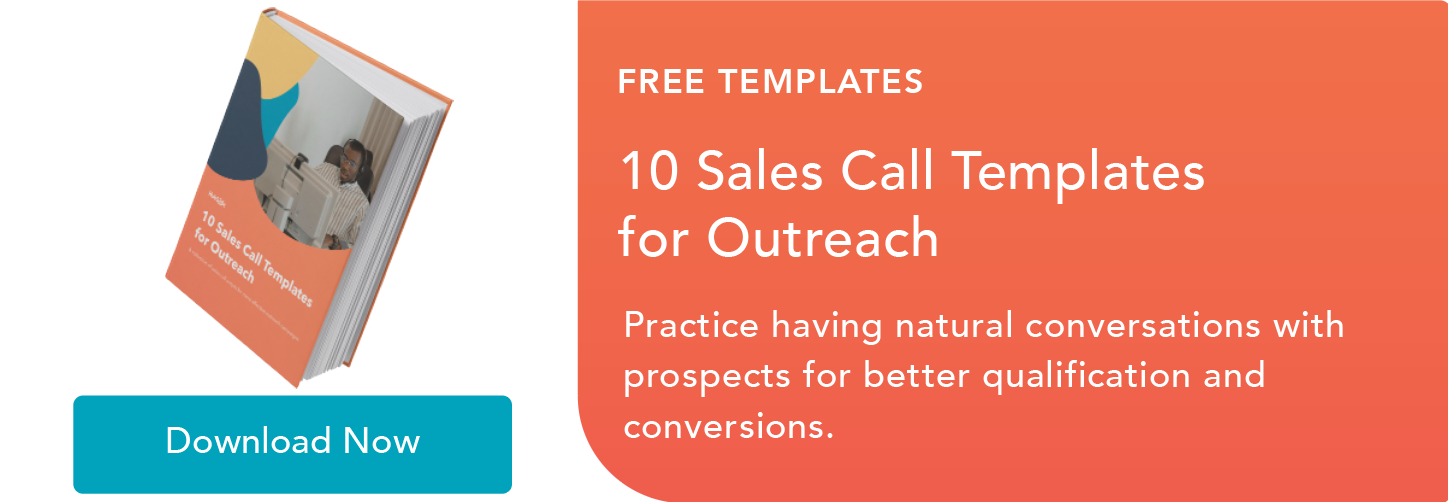Why would you need a script for making a cold call? Consider this. You have your list of names and phone numbers. Before the end of the day, you need to make 100 calls. Your sales manager has given your team a big pep talk encouraging you to dial, dial, dial.

Imagine how stressful it would be to go into each of these calls blind. Now, imagine what you could accomplish with a script that’s clear and persuasive. ![Free Resource: 10 Sales Call Script Templates [Download Now]](https://no-cache.hubspot.com/cta/default/53/64e5789a-605c-4e14-90d9-8aa3df310ee1.png)
In this article, I’ll share more about cold calling and show you what a typical cold call looks like — plus what I consider to be the best cold call script ever.
(If you're in a hurry, skip to the script or download free sales call templates.)
- What is a cold call?
- What is the purpose of cold calling?
- Cold Call Script Examples
- How to Create a Cold Call Script
- The Best Cold Calling Script Ever
- Cold Calling Script Variation
- Cold Calling Script Templates
- Cold Calling Tips
What is a cold call?
A cold call is when sales reps reach out to a potential buyer who's never interacted with them or their company before, with the intent to sell a product or service. Cold calling typically makes use of a sales pitch script to ensure reps sell the product effectively. It's a common practice in outbound sales.
.webp)
10 Free Sales Call Templates
Have better conversations with your sales prospects using these free templates.
- Discovery call template
- Follow-up call template
- Standard outreach template
- And more!
What is the purpose of cold calling?
I’ve found that cold calling is an excellent way to engage prospects one-on-one and move them to the next step in the buying process.
In the past, cold calling meant using a “spray and pray” method, spending time making intrusive calls with no prior qualification, hoping that your message would resonate with someone.
I’m glad that this is no longer the way it’s done because that method led to more rejection and eventually burnout.
Cold calling is most effective when paired with strategies such as prospecting and sales qualification. It's also especially powerful when paired with the inbound methodology.
In inbound sales, prospects willingly “opt-in” and become a lead after encountering your website or campaign. In many cases, prospects need to be compelled to act, and digital channels may not be enough to close the sale. They need to receive a “cold call” from you, where you introduce yourself and your services and make your value proposition clearer. A modern enterprise communication solution can help simplify your outbound communications by connecting your telephone sales with your other digital channels.
Plus, you may not always have an abundance of inbound leads. Even as an outbound tactic, with enough research and qualification, a cold call can be executed in a way that's no longer “cold.”
So, what does a typical cold call look like in sales?
Cold Call Script Examples
**The prospect's phone rings**
Prospect: Hello?
Rep: Aja Frost, my name is Dan from Outbound.
(1.5-second pause)
How are you doing today?
I am calling about our software that helps you with the strategic implementation of your biggest problems from Outbound Company.
Is this a priority for you today?
Prospect: Actually, this isn't a great time …
Rep: Are you interested in a product demo of how we are in the magic quadrant? We have won all these awards.
Prospect: We're not interested.
Rep: Are you the decision-maker? Give me two hours, and we can get you going — unless you don't have a budget.
**Click**
Here's another typical cold call script example.
**The prospect's phone rings**
Prospect: Hello?
Rep: Good morning. Is this Rita?
Prospect: Yes, this is her. With whom am I speaking?
Rep: My name is Bill from DCall. I found your information while searching for business consultants in Wichita, and I think you could be a great fit for our services.
(1.5-second pause)
Do you have a moment to talk about your business' call service provider?
Prospect: I already have one.
Rep: But if I could borrow ten minutes of your time, I can tell you how quickly we can take your business to the next level.
Prospect: Look, I really have to go…
Rep: No problem. When will be a good time to check in with you?
Prospect: I'm not sure.
Rep: Is it okay if I check back in six months?
**Click**
Don‘t laugh. I’ve had several calls in the past just like this, and you won’t be surprised to learn they convert at an abominable rate — less than 1%.
That means if I call 100 people using these kinds of scripts, I will only get a second call with one of them.
Now, if you are calling your prospects and saying the same thing to all of them, essentially pushing your product — just stop.
It likely is no fun for you to make these calls, but it's worse for your prospects, brand, and productivity.
Instead, let me help you create your own cold call script.
How to Create a Cold Call Script
In my experience, the typical, boring cold calling script most salespeople use doesn’t work. Here's how to create a standout cold call script to improve your connect rate.

1. Identify 2-3 verticals.
First, you need to cherry-pick who you‘ll call. Your time is valuable — don’t waste it on prospects that aren‘t a good fit for your product. Think about who your best customers are (or who you’ve had the most success calling in the past) and look for common attributes.
For example, maybe your verticals are hospitality and retail. Or perhaps they‘re finance and banking. Once you’ve figured out which verticals to target, you're ready for step 2.
Cold calling expert Alex Hobbs describes identifying verticals for outbound sales as “critical to revenue attainment today... even inbounds need to be worked with an outbound motion! You can't just be an order taker/the fish are not jumping into the boat anymore!”
2. Identify 20 good-fit prospects.
I’ve found that it’s easier to find specific companies or people who could use your product or service using a tool like LinkedIn.
Let‘s say you’re looking for US-based hotel companies who might benefit from your on-site goat yoga classes (who doesn‘t want to do Shavasana with a baby goat while they’re on vacation?).
Search “General manager” with the “Hospitality” filter.
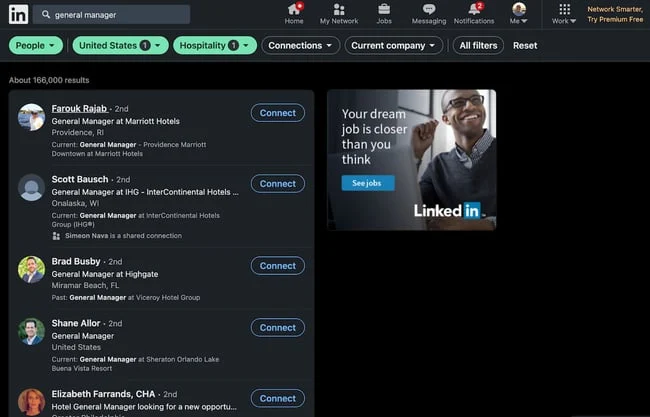
Voila — a list of potential customers.
I’ve also found that regional companies are a great start to your list, as people love to do business with other locals.
3. Research each prospect.
I know, I know, you'd rather just pick up the phone and call. But trust me, spending just a minute upfront will make you wildly more successful.
Since you‘re already on LinkedIn, check out each prospect’s profile to personalize your approach. You'll want to know:
- What the company does.
- What does the prospect do specifically.
- If you've helped a similar company in the past.
- One “fun fact” about them.
Here‘s one thing I never fail to do: Look up how to pronounce the prospect’s name.
Nothing makes people more annoyed and less likely to listen than hearing their name butchered by some fast-talking rep, so this step is crucial.
Some people add how they pronounce their name on Facebook and LinkedIn. If your prospect hasn't added this feature to their profile, try using PronounceNames to get an idea.
And if you‘re still out of luck? Simply ask, "I want to be sure I’m saying your name correctly. How do you pronounce it?"
You should also follow their pronouns if they are listed in their LinkedIn bio. If you’re not familiar with how to use gender-neutral pronouns, here’s a great blog on the topic.
The Best Cold Calling Script Ever To Warm Up Leads
If you're having trouble coming up with a cold call script of your own, try this one. I’ve used this script before, and it works because it focuses on a simple introduction, rapport, and then a positioning statement. I also think it works because the customer immediately sees value because you’ve done your research.
Sample Script
Hi [prospect's name], this is [your name] from [your company name].
I‘ve been doing some research on [prospect’s company name], and I‘d love to learn more about [challenge you’ve discovered in your research].
At [your company name], we work with people like you to help with [value proposition 1, value proposition 2, and value proposition 3.]
Is this something you think could help with [common challenges/pain points]?
Option 1: Yes, tell me more.
Great! [This is where you're going to ask them to attend a demo, or continue the conversation with an Account Executive, or take whatever next steps are part of your sales process.]
Option 2: Objection
I understand. Is it ok if I send you a follow-up email to review at your convenience? Then, I can follow up with you tomorrow.
If yes, send the email and set a reminder to follow up. If not, thank them for their time and ask if there's another point of contact they can connect you with. Make sure to include resources that clearly explain what your company does and ask to continue the conversation.
You may have noticed you're not really cold calling anymore, as you've already winnowed down your list and done some homework all before picking up the phone. I’ve found this extra work to be well worth it in securing customers.
Now, let's get to the script.
1. Introduce yourself.
First, say your name and which company you work for. You need to sound confident and energetic. I can't tell you how many cold calls I listen to that begin with, "This is *mumbles* from ‘mumbled company name.’"
The confused prospect goes, “What? Who?” and right from the start, the call goes poorly.
You don't need to yell your greeting, but you do need to articulate the words.
After you say, “This is [name] from [company],” pause.
This is hard for cold callers. They want to jump straight into their pitch because they’re afraid of rejection. However, I caution you to take a deep breath and say nothing for eight whole seconds.
While you're pausing, your prospect is searching their brain for who you could be. It sounds like you know them — are you a client? A former coworker? A current one?
2. Establish rapport.
Now that the call is already deviating from the standard cold call, ask them a question to establish some rapport. Your goal here is to get them talking and prove you're familiar with them and their company.
Here are some sample questions:
- Wow, I see you've been at [company] for [X years]. What do you enjoy about your role?
- Congrats on your recent promotion. How is your new position going?
- I’ve always been fascinated by the [enter industry they work in] industry. Can you tell me more about what your company does?
A good question is topical and makes someone smile. If they seem receptive to chatting, ask them a follow-up question. You don’t want to ask something too personal since this is likely the first time they’ve spoken to you, so stay away from information that’s not readily available on LinkedIn.
For instance, if they say, “I’m enjoying my new promotion; I’m able to get a lot more done,” you can respond, “That's great. How did you get started in this industry?” Maybe comment on a post they’ve recently made and how it made you think.
Eventually, they'll ask, “Alright, why are you calling?”
Acknowledge that their time is valuable and you have a pitch for them while still keeping the mood light. Be cordial and merry on the phone. This will change the energy from one of awkwardness to lightheartedness.
3. Use a positioning statement.
A positioning statement shows your prospect that you work with similar companies and understand their challenges. You're not talking about yourself, which is what most cold callers do. Keep the conversation light on them and have a genuine discussion.
Here's a hypothetical positioning statement:
“I work with sales managers in hospitality with five to eight reps on their team. My customers are typically looking to increase rep productivity. Does that sound like you?”
Since you‘ve pre-qualified them, they’ll likely say “yes.”
Simply say, “Tell me more about that.”
Now, it‘s all about them! They’ll explain their pain points and objectives, which is valuable information you can use to build your sales pitch.
4. Thank them for their time.
Never end a cold call without letting your prospect know you’re grateful for the chance to speak with them.
Pranav Rawat, a cold calling professional, teaches this concept by stating that “no matter who your prospect is, their time is important. By saying thank you, you’re letting them know that you respect them, which is not only a good opening line but a great way to start a relationship, too.”
Cold Calling Script Variation
As a sales leader at HubSpot, I love assisting newer reps in closing big deals because I‘ve been in their shoes. It’s good for the company and the reps' careers. To do that, I use a slightly altered process and script.
We have a team culture of “just ask,” encouraging junior reps to request help from sales leaders when they want to get meetings with CEOs or prospects at Fortune 500 companies. Once a rep asks for my help, I ask for something in return: The website URL, the LinkedIn profile of the person and company I'm speaking with, and their HubSpot CRM record.
This allows me to quickly familiarize myself with the person and company I'm about to call. Once the phone rings and the prospect answers, I use the greeting from above, “This is [name] from [company],” then pause.
If you‘re calling a C-level executive or even a mid-level employee at a large organization, it’s likely you had to get past an assistant or front desk, which is where your senior title helped. Gatekeepers are more likely to pass along “Dan Tyre, Director of Sales at HubSpot” than “[Name], a sales rep at HubSpot.”
They‘ll know who you are, but they’ll still be curious why you called. Keep them in suspense a bit longer. As in the script above, I'll spend a few minutes asking about them. Here are a few more questions I turn to:
- “Are you a cat or a dog person?”
- “Read any good books or blogs lately?”
- "What‘s your favorite restaurant in [Prospect’s city]? I’ve always wanted to visit.”
When the conversation turns to why I called, I say, “I called to help.” This line usually stops the prospect in their tracks.
Then, I follow up with, “My sales rep asked me to start a conversation with you.” This allows me to easily hand the conversation off to the rep if it goes well.
From there, I use a positioning statement like the one above:
“I work with sales managers in hospitality with five to eight reps on their team. My customers are typically looking to increase rep productivity. Does that sound like you?”
The pre-qualified prospect will answer “Yes,” and that's when my active listening turns on, and I say, “Tell me more about that.” Once they‘ve finished explaining their pain points, I repeat what I’ve heard back to them: “So, what I'm hearing is …” and offer to set up a discovery call.
Usually, the prospect agrees and throws out a time for weeks or months in the future. I often reply with, “How about tomorrow?” Most of the time, prospects respond with, “Sure, what time?”
I‘ll then check the junior rep’s calendar and schedule the discovery call.
Everyone wants to have a better day. By making your prospects smile or laugh, giving them a chance to talk about their problems, and showing them you might have a solution, you'll improve their day. That means stronger relationships and, ultimately, more sales.
Cold Calling Script Templates
Ready to start cold calling? Here are some cold-calling script templates you can use to get started.
Featured Resource: 10 Sales Call Templates for Outreach.
This downloadable resource contains ten templates, including the examples listed below. I like that each script can be customized to fit your specific needs and scenarios. As stated previously, the more research you do on your prospect prior to calling, the better your results will be.
Discovery Sales Calls
I think this is a great script for getting more information out of your prospect.

Gatekeepers
This is the best script for navigating screening conversations with administrative assistants or office managers.
.webp)
Mutual Colleague Recommendations
I like that this script shows you the most effective way to use a recommendation from a mutual colleague.
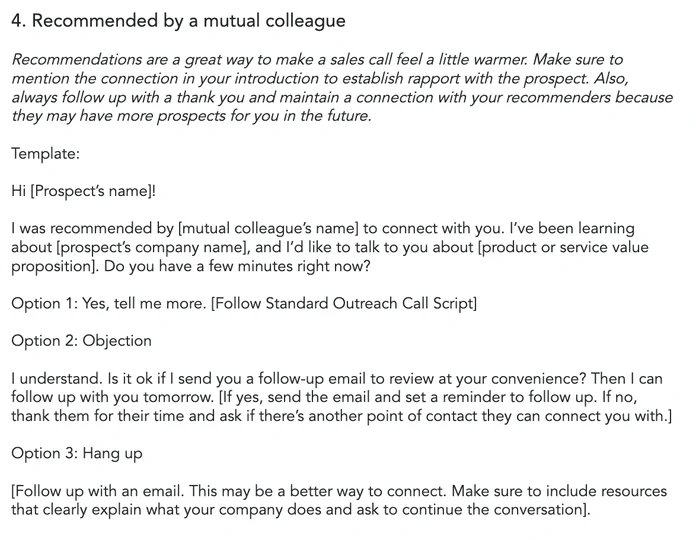
Follow-ups
If you've already tried reaching out to a prospect, this script will help you follow up and get a response.
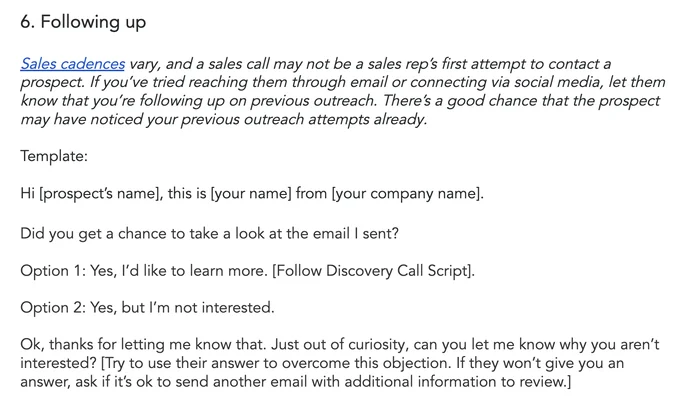
Connection Requests
Failing to connect with a prospect? This script provides an alternative route to reaching out.
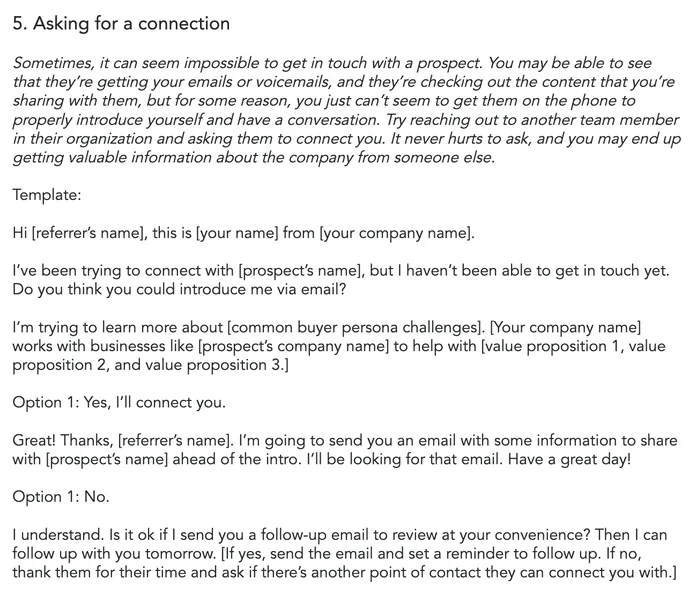
21 Cold Calling Tips
- Be selective with prospects.
- Practice your cold call script.
- Focus on them.
- Do your research.
- Find the best time to call.
- Pique curiosity.
- Be respectful of their time.
- Ask open-ended questions.
- Be an active listener.
- Pick out their pains.
- Anticipate objections.
- Use social proof.
- Focus on your goal.
- Have a 'close' in mind for every conversation.
- Make it easy to say yes.
- Follow up after the call.
- Leave a voicemail.
- Conduct call reviews.
- Spend more time selling.
- Make sure you offer value.
- Remember your why.
Now that you have your script, here are some tips to keep in mind.
1. Be selective with prospects.
As an employee of HubSpot, I try to live and breathe inbound marketing and sales, relying on my strong sales teams to close deals.
I know that a 100% inbound method might not work for your business — at least not overnight.
So, be selective with your prospects to mimic the success of inbound sales. That means you‘ll need to get creative with whom you add to your list. If you can find hand-raisers (people already interested in the product or service your company provides), prioritize calling them first. If they’re interested in what you have to offer before you call, you'll be well on your way to closing them on the solution you sell.
2. Practice your cold call script.
While you don‘t want to sound robotic and rehearsed, you do want to repeat your script so you don’t forget it.
The better you know the goals of the script, you‘ll be able to think on your feet if the prospect comes back with a comment or question you hadn’t planned for.
With each call, you‘ll get a chance to practice your cold calling script — and you’ll learn strategies to make future cold calls more effective.
3. Focus on them.
When I craft a cold-calling script, I find it’s easy to fall into the me-me-me trap:
- “We at [Company] offer...”
- “We're the best at...”
- “I want to schedule a meeting to...”
Instead, you should be putting your focus on the prospect using “you” language:
- "Are you experiencing challenges with..."
- "What roadblocks kept you..."
- "Would you benefit from..."
Doing so centers them in the conversation, making it personalized and relevant.
4. Do your research.
Before you even think about picking up the phone, you should have plenty of information about the prospect you're reaching out to.
I try to know what the company does, the prospect's role at the company, whether I’ve worked with a similar company in the past, and any additional facts I can use to build rapport with them.
Where did they go to school? Do you know a friend or colleague? Did they recently attend an industry event? These are some rapport-building topics you can use to start the conversation.
5. Find the best time to call.
Although there isn't a universal “best” time to make a cold call, some experts recommend early mornings or late afternoons since individuals haven't yet started their day or are already wrapping it up — thus increasing your chances of getting through.
However, the more cold calls you make, the more you'll get a feel for the days and times that have the most success. Once you do, prioritize your calls and make the most important ones during those windows.
6. Pique curiosity.
I try to open the conversation by generating intrigue and interest. If you can get prospects invested in the conversation, you'll give them a reason to keep listening.
Harvard Business Review studied curiosity in the workplace and found that curiosity correlates with less defensiveness and stress. Curious prospects might give you more of their time to explore solutions to their problems.
7. Be respectful of their time.
While it's essential to establish rapport and start the conversation off on a positive note, be mindful that cold-calling is somewhat intrusive. You have interrupted their day, and you should get to the point quickly to respect their time.
Use your positioning statement early on in the call or make a transition like this one: “The reason I'm calling is to...”
These will signal to the prospect that you're about to be quick and to the point.
8. Ask open-ended questions.
I avoid asking “yes or no” questions. Instead, ask open-ended questions that will keep the conversation going, especially when asking the prospect about their pain points and goals.
You could say:
Hi [prospect's name], this is [your name] from [your company name].
I‘ve been doing some research on [prospect’s company name], and I just wanted to ask you a few questions about [insert chosen topic].
What roadblocks have kept you from finding a better solution to [insert chosen topic challenges]?
(They answer)
I'd love to continue the conversation because I think [your company name] would be able to help you figure out a solution. [Then take whatever next steps are part of your sales process.]
Asking open-ended questions will help you get more information out of the prospect and will help you tailor a solution to their specific challenges.
9. Be an active listener.
It can be easy to get lost in the conversation, but ensure you‘re listening carefully to the prospect’s responses.
When appropriate, repeat what they said about their company or goals. This helps you clarify what they said and shows the prospect that you truly care about what they're saying.
10. Pick out their pains.
I’ve found that, often, eliminating pain is more powerful at incentivizing prospects than adding value. As you get the prospect to open up about their organization, role, and situation, listen for current struggles, points of contention, or problems they may be experiencing.
This may give you an “I can help with that” moment with the prospect.
You can build off of the open-ended questions script:
Hi [prospect's name], this is [your name] from [your company name].
We‘re a [type of company] platform that helps companies like yours [problem you solve]. I’m calling to see if we can provide assistance.
What roadblocks have kept you from finding a better solution to [insert chosen topic challenges]?
(They answer)
I can totally understand your frustration with that. It sounds like your team is having trouble with [summarize their pain points/issue]. We work with a few companies like yours, and most have found our services to be [how your product/service helped]. Do you have something similar in place?
This script helps you nail down their challenges and presents your services as a remedy.
11. Anticipate objections.
The more calls you complete, the more you‘ll get a feel for the types of objections you’ll get.
For example, the prospect may already be working with a competitor. You could respond with:
“Yes, I am familiar with them. Why did you choose [company name]? What's working? What's not? Allow me to explain how [your product/service] is different.”
Certainly, there will be some cases where you don‘t want to waste the prospect’s time.
But for the cases where it is a good opportunity to press on, having a scripted response to handle the objection will keep you from getting caught off guard and allowing the call to come to a grinding halt.
12. Use social proof.
Once I’ve discovered that my prospect is an ideal client, I guide the conversation to what I have to offer them. But I don’t expect them to take my word for it; I will:
- Tell stories about customers with similar business structures as them, illustrating what I was able to do for those customers.
- Use case studies that show what they stand to gain.
- Show testimonials and success stories.
13. Focus on your goal.
The goal of each cold call is to introduce yourself to the prospect and set up a discovery call with them. Remind yourself of the desired end result. This will help you stay on track as you're cold-calling prospects.
14. Have a ‘close’ in mind for every conversation.
Sales pro Jeff Hoffman recommends always having a small close in mind for every point of contact you have with a prospect. For a cold call, that small close might be getting five more minutes of a prospect's time or setting up a follow-up call for later in the week.
Before each email you send and phone call you make, identify the close you'll use to encourage more streamlined and focused communication.
15. Make it easy to say yes.
Regardless of which ‘close’ you end up choosing, focus on selling just that ‘close.’ The more complicated you make it for the prospect, the easier it is for them to say ‘no.’
For example, if the big goal is to sell a turn-key software package in the four figures, but you know that your demo will blow them out of the water, just sell the demo.
Make it easy for them to commit to the demo with no strings attached, and make it easy for them to schedule and show up to the demo. Don't fuss with the details about software packages in this initial step when you can deal with those details later (presumably after the demo). Doing so will plant objections in their mind before you get your foot in the door.
If I know that a prospect won’t commit to a demo, I assume that they need more time in the purchase funnel, and that means more useful content. I send them articles, blogs, handouts, white papers, etc., that will make their life easier and help them excel in their industry. Remember, “Value is not what you say it is; it is always what the buyer perceives it to be” (Art Sobczak).
16. Follow up after the call.
If my prospect isn't available to meet again until the next week or so, I will follow up with them within a day after our initial cold call. I try to go beyond the traditional “thanks for your time” and offer some valuable information that could help them in the period between our last conversation and their decision about my product.
You could try something like:
Hi [prospect's name], this is [your name] from [your company name].
Did you get a chance to take a look at the materials I sent over?
If they say yes, follow up with some discovery questions or the next step in your sales process.
If they say they're not interested, you could end with:
Thanks for letting me know. Just out of curiosity, could you tell me why you aren't interested? [Try to use their answer to overcome this objection].
17. Leave a voicemail.
In today‘s digital world, voicemails can seem like an old-fashioned method of communicating with your prospects, but they’re a smart way to keep yourself top-of-mind with them when they check their messages. When your prospects have overflowing email inboxes daily, stand out with a voicemail.
Hi, this is [your name] from [company name].
I'd like to learn more about [chosen topic] to see if [your company name] can offer a solution.
You can reach me at [your number]. I'll also follow up with an email [specified date/time]. I look forward to speaking with you.
Have a great day.
You can even adjust your cold calling script to work with voicemail. Remember to address the prospect by name, introduce yourself, your company, and the need you‘re planning to address with them. Don’t sell in the voicemail; provide just enough information to pique their interest.
18. Conduct call reviews.
I try to never let my cold call script or etiquette get stale. As my product or service evolves, so should my cold call technique.
Conduct a call or “film” review with your sales team on a monthly or quarterly basis. Select a few recorded (with permission) calls, sit in on a few live attempts, and have reps provide constructive feedback on what went well and what could be improved for the next time.
19. Spend more time selling.
I’ve found that sales automation software is a sales rep‘s best friend. Little tasks like scheduling meetings, leaving voicemails, and sending follow-up emails might only take a few seconds to do, but when you multiply that by your daily quota, you’ll see hours per week spent on administrative tasks.
Automate these responsibilities with software that can do the work for you. These platforms streamline manual tasks so you can spend more time doing something technology can't — researching your prospects, building rapport, and closing deals.
19. Make sure you offer value.
I often ask myself after a call what value I offered my prospect. If I’m not answering their questions and solving their pain points, I’m wasting both their time and mine. If I don’t think I’ve established enough value, I send them more content to help them learn what my product/business has to offer them. Never underestimate the importance of educating your prospect with free, valuable content.
In his book Cold Calling Techniques, Stephan Schiffman says, “Success comes from helping people do what they want to do, not what you want to do.” Make sure your priority is helping your prospects accomplish the things they want to accomplish at their organization.
21. Remember your why.
Cold calling gets pretty robotic pretty fast. Dialing, reciting your script, asking for the next call, and doing it all over again can start to wear on your enthusiasm, but don‘t let it. When you’re struggling to make it through those last few calls of the week, remember why you love to do what you do.
Whether you keep your family‘s picture on your desk, an inspiring note from a colleague, or an encouraging quote from a leader, always keep your "why" in mind. On those amazing days when you’re closing left and right and those slower days when you can't quite get into your groove, your “why” will keep you motivated.
Famous saleswoman Mary Kay Ash said, “Pretend that every single person you meet has a sign around his or her neck that says, ‘Make me feel important.’ Not only will you succeed in sales, you will succeed in life.”
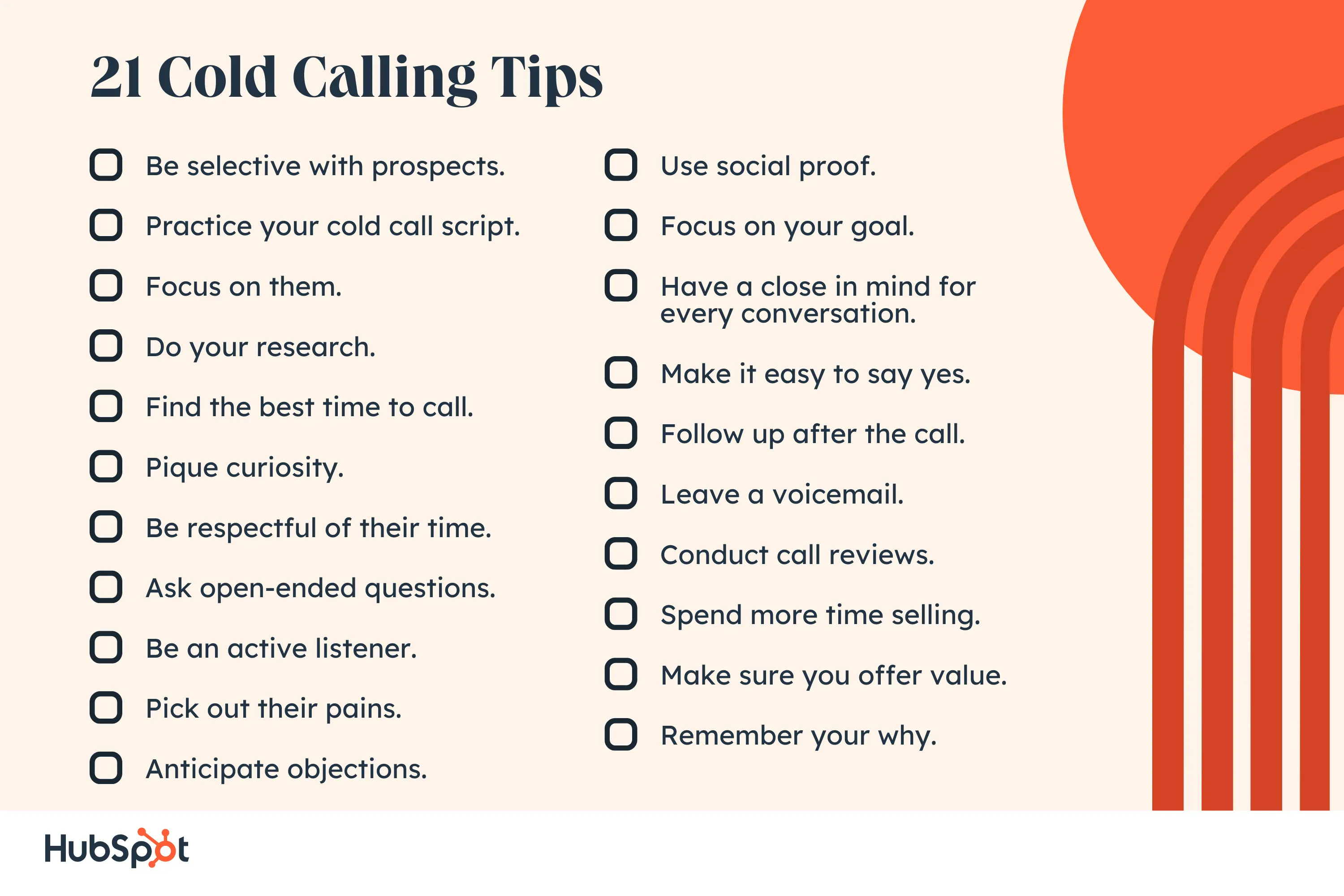
Cold Call Script Templates That Work
This script and these tips will help you be a more effective cold caller. Just remember that it‘s all about providing value. By piquing a customer’s curiosity and solving their needs, you’ll build rapport and win prospects over, even if the conversation began “cold.”
The work doesn‘t stop here. You’ll need to tailor your new script and template to fit your business, prospects, and personal style. Once you do, you'll see a much higher return for your efforts.
Editor's note: This post was originally published in September 2017 and has been updated for comprehensiveness.
